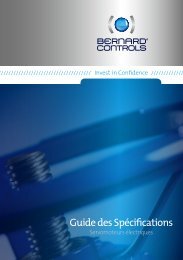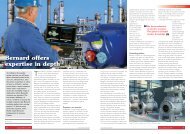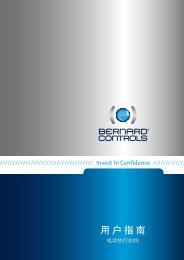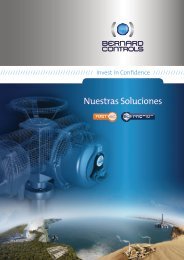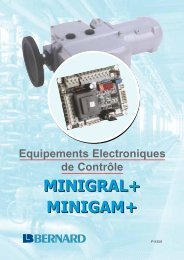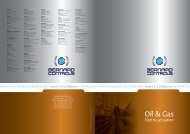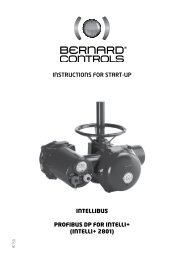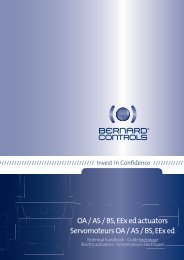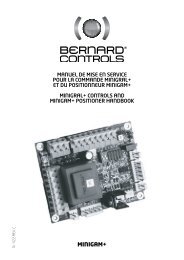User's Guide - Bernard Controls
User's Guide - Bernard Controls
User's Guide - Bernard Controls
Create successful ePaper yourself
Turn your PDF publications into a flip-book with our unique Google optimized e-Paper software.
12 13<br />
Type of operation<br />
of the device to be driven<br />
Modulating classes<br />
Type of operation<br />
Modulating class<br />
Durability and accuracy are the most important criteria during valve modulating.<br />
Depending on operation frequency and accuracy of positioning, BERNARD CONTROLS<br />
has defined four modulating classes.<br />
Modulating class<br />
Open or close the full stroke,<br />
on average 20 to 30 times/day.<br />
On-Off<br />
ON/OFF<br />
Class III<br />
Modulating<br />
Class II<br />
Modulating<br />
Class I<br />
Modulating<br />
Select intermediate positions,<br />
with good precision (better than 2 %)<br />
on average 360 times/day.<br />
Select intermediate positions, with high<br />
precision (better than 1 %) on a permanent<br />
basis every 2 or 3 seconds.<br />
Fast positioning with an excellent<br />
precision (0.5 % or better) and continuous<br />
movement.<br />
CLASS III modulating<br />
CLASS II modulating<br />
CLASS I modulating<br />
Maximum operation<br />
frequency recommended<br />
to ensure<br />
the life time<br />
20-30 per day 360 per day Every 2-3 seconds Continuous<br />
Motor duty cycle S4 - 30 % S4 - 50 % S4 - 100 % S4 - 100 %<br />
Maximum motor<br />
starts rate at peaks<br />
of operation<br />
Specific technology<br />
360 starts/h (AC)<br />
60 starts/h (DC)<br />
1200 starts/h 1800 starts/h No limit<br />
• Motor under<br />
limited heating<br />
• High mechanical<br />
efficiency<br />
• Low inertia motor<br />
• Solid state<br />
contactors<br />
• High mechanical<br />
efficiency<br />
• DC Brushless Motor<br />
with continuous<br />
speed control<br />
General characteristics<br />
of AC motors<br />
• SQUIRREL CAGE type<br />
• Insulation CLASS F<br />
• Weatherproof enclosure<br />
• Built-in thermal protection<br />
What are the classes<br />
of modulating?<br />
The choice of an operation type determines the selection of a motor for each function. According to IEC 34<br />
Standard defining the electric motors standard duty cycles, <strong>Bernard</strong> <strong>Controls</strong> has chosen the S4 duty rating,<br />
because it is the most representative duty cycle for actuators operations.<br />
S1<br />
Duty cycles according to IEC 34 standard<br />
CONTINUOUS DUTY<br />
Operation with constant load over a sufficient duration for reaching a thermal<br />
equilibrium.<br />
A modulating actuator has to be fully adapted to the operating duty<br />
of the modulating loop. Two points are important for enhancing the reliability<br />
of the actuator:<br />
• The lifetime of equipment is related to the number of operations (motor,<br />
mechanism, electronic…) or to the change of positions,<br />
• The motor must stand up to overheating.<br />
Although the electric motor is important, it is not the only element to<br />
take into account when choosing an actuator. Therefore, <strong>Bernard</strong><br />
<strong>Controls</strong> proposes a classification of actuators according to four types<br />
of operations named MODULATING CLASSES. It has deeply inspired the<br />
classification used in the European electric actuator standard EN 15714-2.<br />
S2<br />
S3<br />
S4<br />
SHORT TIME DUTY<br />
Short time operation, total cooling between each start.<br />
INTERMITTENT PERIODIC DUTY<br />
The starting current has no significant effect on temperature rise. To be followed<br />
by the maximum operating time.<br />
INTERMITTENT DUTY WITH STARTING<br />
Repetition of cycles including:<br />
• starting period D<br />
• period of constant speed N<br />
• rest period R<br />
To be followed by the duty factor in %, as well as the number of starts per hour.<br />
Our choice : S4 - The only representative duty cycle for actuator operation is S4.



